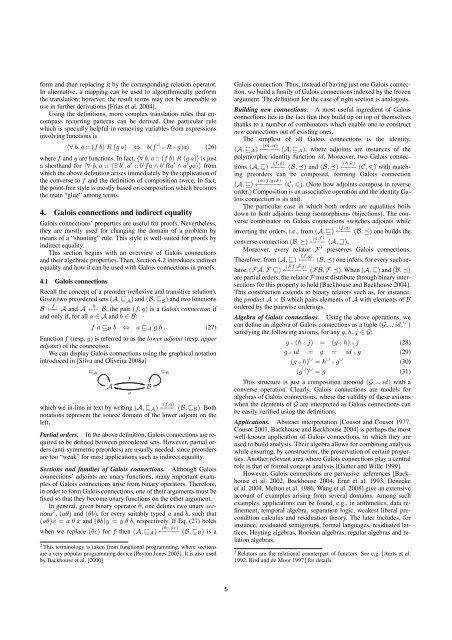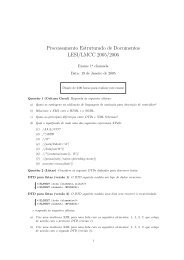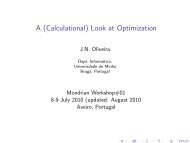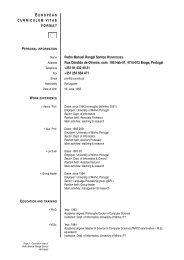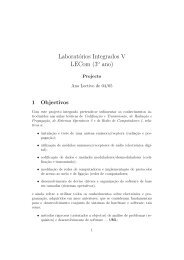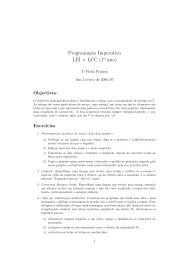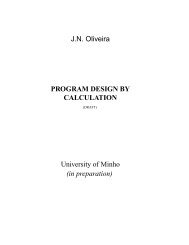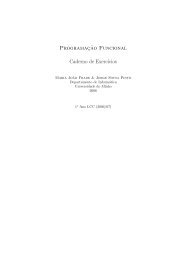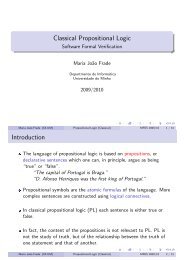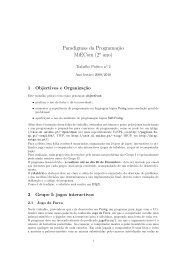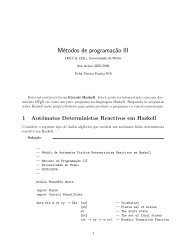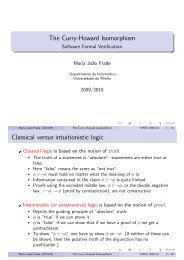Galois
Galois
Galois
Create successful ePaper yourself
Turn your PDF publications into a flip-book with our unique Google optimized e-Paper software.
form and then replacing it by the corresponding relation operator.<br />
In alternative, a mapping can be used to algorithmically perform<br />
the translation; however, the result terms may not be amenable to<br />
use in further derivations [Frias et al. 2004].<br />
Using the definitions, more complex translation rules that encompass<br />
recurring patterns can be derived. One particular rule<br />
which is specially helpful in removing variables from expressions<br />
involving functions is<br />
〈∀ b, a :: (f b) R (g a) ⇔ b(f ∪ ◦ R ◦ g)a〉 (26)<br />
where f and g are functions. In fact, 〈∀ b, a :: (f b) R (g a)〉 is just<br />
a shorthand for 〈∀ b, a :: 〈∃ b ′ , a ′ :: b ′ fa ∧ b ′ Ra ′ ∧ a ′ ga〉〉 from<br />
which the above definition arises immediately by the application of<br />
the converse to f and the definition of composition twice. In fact,<br />
the point-free style is mostly based on composition which becomes<br />
the main “glue” among terms.<br />
4. <strong>Galois</strong> connections and indirect equality<br />
<strong>Galois</strong> connections’ properties are useful for proofs. Nevertheless,<br />
they are mostly used for changing the domain of a problem by<br />
means of a “shunting” rule. This style is well-suited for proofs by<br />
indirect equality.<br />
This section begins with an overview of <strong>Galois</strong> connections<br />
and their algebraic properties. Then, Section 4.2 introduces indirect<br />
equality and how it can be used with <strong>Galois</strong> connections in proofs.<br />
4.1 <strong>Galois</strong> connections<br />
Recall the concept of a preorder (reflexive and transitive relation).<br />
Given two preordered sets (A, ⊑ A ) and (B, ⊑ B ) and two functions<br />
B ←− f<br />
A and A ←− g<br />
B, the pair (f, g) is a <strong>Galois</strong> connection if<br />
and only if, for all a ∈ A and b ∈ B:<br />
f a ⊑ B b ⇔ a ⊑ A g b . (27)<br />
Function f (resp. g) is referred to as the lower adjoint (resp. upper<br />
adjoint) of the connection.<br />
We can display <strong>Galois</strong> connections using the graphical notation<br />
introduced in [Silva and Oliveira 2008a]<br />
⊑ A<br />
A<br />
f<br />
g<br />
which we in-line in text by writing (A, ⊑ A) (f,g)<br />
←−−− (B, ⊑ B). Both<br />
notations represent the source domain of the lower adjoint on the<br />
left.<br />
Partial orders. In the above definition, <strong>Galois</strong> connections are required<br />
to be defined between preordered sets. However, partial orders<br />
(anti-symmetric preorders) are usually needed, since preorders<br />
are too “weak” for most applications such as indirect equality.<br />
Sections and families of <strong>Galois</strong> connections. Although <strong>Galois</strong><br />
connections’ adjoints are unary functions, many important examples<br />
of <strong>Galois</strong> connections arise from binary operators. Therefore,<br />
in order to form <strong>Galois</strong> connections, one of their arguments must be<br />
fixed so that they become unary functions on the other argument.<br />
In general, given binary operator θ, one defines two unary sections<br />
2 , (aθ) and (θb), for every suitably typed a and b, such that<br />
(aθ)x = a θ x and (θb)y = y θ b, respectively. If Eq. (27) holds<br />
when we replace (θc) for f then (A, ⊑ A) ←−−−− (θc,φc)<br />
(B, ⊑ B) is a<br />
2 This terminology is taken from functional programming, where sections<br />
are a very popular programming device [Peyton Jones 2003]. It is also used<br />
by Backhouse et al. [2000]<br />
B<br />
⊑ B<br />
<strong>Galois</strong> connection. Thus, instead of having just one <strong>Galois</strong> connection,<br />
we build a family of <strong>Galois</strong> connections indexed by the frozen<br />
argument. The definition for the case of right section is analogous.<br />
Building new connections. A most useful ingredient of <strong>Galois</strong><br />
connections lies in the fact that they build up on top of themselves<br />
thanks to a number of combinators which enable one to construct<br />
new connections out of existing ones.<br />
The simplest of all <strong>Galois</strong> connections is the identity,<br />
(A, ⊑ A) ←−−−− (id,id)<br />
(A, ⊑ A), where adjoints are instances of the<br />
polymorphic identity function id. Moreover, two <strong>Galois</strong> connections<br />
(A, ⊑) ←−−− (f,g)<br />
(B, ≼) and (B, ≼) ←−−− (h,k)<br />
(C, ) with matching<br />
preorders can be composed, forming <strong>Galois</strong> connection<br />
(A, ⊑) ←−−−−−− (h◦f,g◦k)<br />
(C, ). (Note how adjoints compose in reverse<br />
order.) Composition is an associative operation and the identity <strong>Galois</strong><br />
connection is its unit.<br />
The particular case in which both orders are equalities boils<br />
down to both adjoints being isomorphisms (bijections). The converse<br />
combinator on <strong>Galois</strong> connections switches adjoints while<br />
inverting the orders, i.e., from (A, ⊑) ←−−− (f,g)<br />
(B, ≼) one builds the<br />
converse connection (B, ≽) ←−−− (g,f)<br />
(A, ⊒).<br />
Moreover, every relator F 3 preserves <strong>Galois</strong> connections.<br />
Therefore, from (A, ⊑) ←−−− (f,g)<br />
(B, ≼) one infers, for every such relator,<br />
(FA, F ⊑) ←−−−−− (Ff,Fg)<br />
(FB, F ≼). When (A, ⊑) and (B, ≼)<br />
are partial orders, the relator F must distribute through binary intersections<br />
for this property to hold [Backhouse and Backhouse 2004].<br />
This construction extends to binary relators such as, for instance,<br />
the product A × B which pairs elements of A with elements of B<br />
ordered by the pairwise orderings.<br />
Algebra of <strong>Galois</strong> connections. Using the above operations, we<br />
can define an algebra of <strong>Galois</strong> connections as a tuple (G, ◦, id, ∪ )<br />
satisfying the following axioms, for any g, h, j ∈ G:<br />
g ◦ (h ◦ j) = (g ◦ h) ◦ j (28)<br />
g ◦ id = g = id ◦ g (29)<br />
(g ◦ h) ∪ = h ∪ ◦ g ∪ (30)<br />
(g ∪ ) ∪ = g (31)<br />
This structure is just a composition monoid (G, ◦, id) with a<br />
converse operation. Clearly, <strong>Galois</strong> connections are models for<br />
algebras of <strong>Galois</strong> connections, where the validity of these axioms<br />
when the elements of G are interpreted as <strong>Galois</strong> connections can<br />
be easily verified using the definitions.<br />
Applications. Abstract interpretation [Cousot and Cousot 1977,<br />
Cousot 2001, Backhouse and Backhouse 2004] is perhaps the most<br />
well-known application of <strong>Galois</strong> connections, in which they are<br />
used to build analysis. Their algebra allows for combining analysis<br />
while ensuring, by construction, the preservation of certain properties.<br />
Another relevant area where <strong>Galois</strong> connections play a central<br />
role is that of formal concept analysis [Ganter and Wille 1999].<br />
However, <strong>Galois</strong> connections are pervasive: references [Backhouse<br />
et al. 2002, Backhouse 2004, Erné et al. 1993, Denecke<br />
et al. 2004, Melton et al. 1986, Wang et al. 2008] give an extensive<br />
account of examples arising from several domains. Among such<br />
examples, applications can be found, e.g., in arithmetics, data refinement,<br />
temporal algebra, separation logic, weakest liberal precondition<br />
calculus and residuation theory. The later includes, for<br />
instance, residuated semigroups, formal languages, residuated lattices,<br />
Heyting algebras, Boolean algebras, regular algebras and relation<br />
algebras.<br />
3 Relators are the relational counterpart of functors. See e.g. [Aarts et al.<br />
1992, Bird and de Moor 1997] for details.<br />
5


